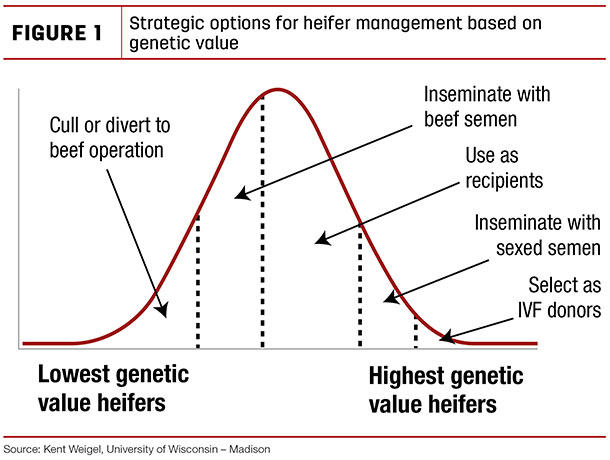Advanced reproductive technologies such as in vitro fertilization (IVF) offer significant opportunities for genetic advancement in your dairy operation, but if you’re like most commercial producers, you have one burning question: “What is the economic return?”
Evaluating the potential return on investment (ROI) is a critical first step to successful IVF adoption.
First, the basics: IVF involves harvesting oocytes – or eggs – from a female and fertilizing them in a laboratory environment. The resulting embryos are then implanted fresh into donor females or frozen for future implantation. While IVF is a well-established practice in elite registered herds, the technology has evolved to become accessible and profitable for commercial dairy operations as well.
Using IVF strategically
The key to a positive ROI is using IVF strategically to multiply the best genetics in your herd. For many operations, the most profitable approach combines IVF with genomic testing to accelerate genetic progress and produce high-value herd replacements.
Dr. Kent Weigel, professor of breeding and genetics at the University of Wisconsin – Madison, discussed IVF strategies during a presentation at the 2019 Western Dairy Management Conference (WDMC). Weigel outlined reproductive management options that combine IVF with A.I. and sexed semen.
The professor suggested producers use pedigrees and Net Merit Dollars (NM$) genomic values to set heifers on different career paths based on their genetic potential. Weigel shared examples of how heifers with different genetic values might be managed differently:
-
Highest genetic value heifers: Channel these animals into an IVF program to create more high-producing replacements.
-
Second-highest genetic value heifers: Breed to A.I. sires using sexed semen to produce a higher number of heifers.
-
Next tier of genetic value heifers: Use as recipients for IVF program.
-
Second-lowest genetic value heifers: Inseminate with beef semen to create value-added crossbred calves.
- Lowest genetic value heifers: Cull as calves to save feed costs, or divert to beef operation.
Figure 1 illustrates these management options using a bell curve of a typical herd’s genetic distribution.

In practice, a dairy producer would adjust these strategies to fit specific herd goals, cow numbers, available labor and beef market potential.
The bottom line: Strategic use of IVF allows dairy producers to fast-track herd improvement through genetically superior heifers. Through new IVF techniques, oocytes can be collected from high-genetic-value females as young as 6 to 9 months old.
That means a female can have several genetic offspring on the ground by the time she has a natural calf through conventional A.I. breeding. That’s how IVF produces more high-value replacements that generate greater return to the operation through higher milk production and more efficient use of fixed and variable costs.
Researching IVF ROI
In recent years, researchers have explored the economic viability of IVF and other reproductive technologies in commercial dairy settings.
In a 2018 study at the University of Florida, researchers analyzed genetic and financial gains using a mix of A.I. and IVF. The study found the highest profitability when 40 percent of the total pregnancies in the herd came from IVF. Following are the researchers’ net profit calculations for various combinations of reproductive management practices:
- 0 percent IVF and 100 percent A.I. = $1,619 net profit per cow
- 40 percent IVF and 60 percent A.I. = $1,685 net profit per cow
- 80 percent IVF and 20 percent A.I. = $1,654 net profit per cow
- 100 percent IVF and 0 percent A.I. = $1,641 net profit per cow
Other economic factors
Depending on the operation, these additional considerations may factor into an individual herd’s economic returns from IVF:
-
Improved conception rates. In times of lower milk prices, it’s critically important to reduce days open. For herds struggling with fertility, such as during times of heat stress, IVF may help achieve a higher conception rate and improve reproductive efficiency.
-
Lower semen costs. In a lab setting, fertilization of oocytes uses a fraction of a unit of semen. Therefore, IVF can stretch the value of your semen by generating more embryos from a single semen unit spread out over several fertilization sessions.
-
Your dairy’s long-term goals. Do you want to grow your herd? Are you targeting a premium milk market? Are you working toward specific genetic improvement goals? IVF may be a faster path to reach those long-term goals. For example, if your herd is primarily Holsteins, you may be interested in adding Jersey genetics to improve milk components and lower feed costs.
If so, IVF would allow you to mate high-genomic Holstein heifers with Jersey bulls to create high-value F1 crossbreds. Previously, it took generations to make significant changes to a herd’s genetics. IVF provides the flexibility to adapt genetics to meet your business goals and market demands.
Setting up IVF for success
To get the maximum payback from IVF, keep in mind that no technology is a silver bullet to overcome reproductive management issues on the dairy. For profitable use of IVF, first ensure your herd health and nutrition programs promote high conception rates and low embryonic loss. Pay attention to vaccination programs, proper training for your labor force and pre-fresh and calving management. Addressing these basics will enhance the potential economic return from IVF.
Ultimately, making the decision of what’s best for your dairy takes planning and attention to management. As IVF techniques continue to advance, the management benefits and success rates can make IVF a profitable solution for your operation.
References omitted but are available upon request by sending an email to the editor.






